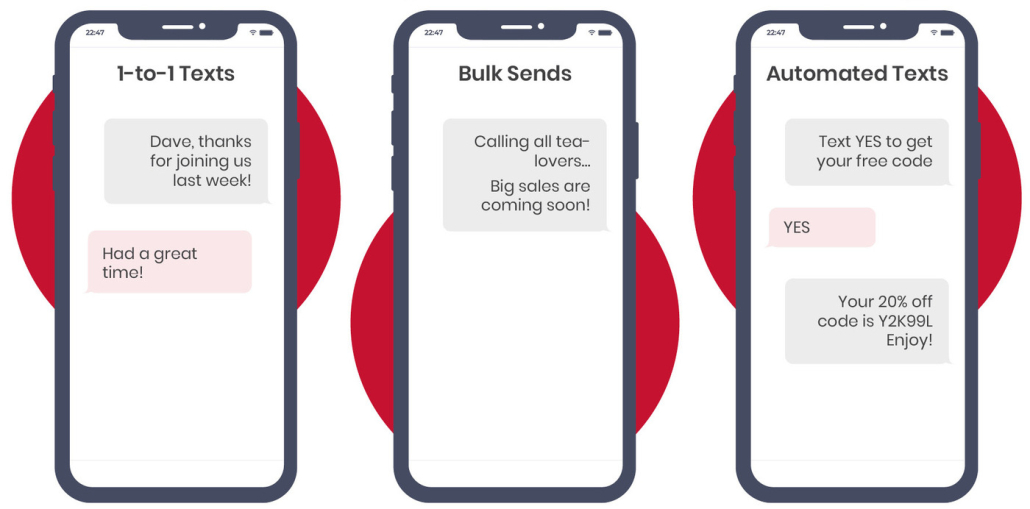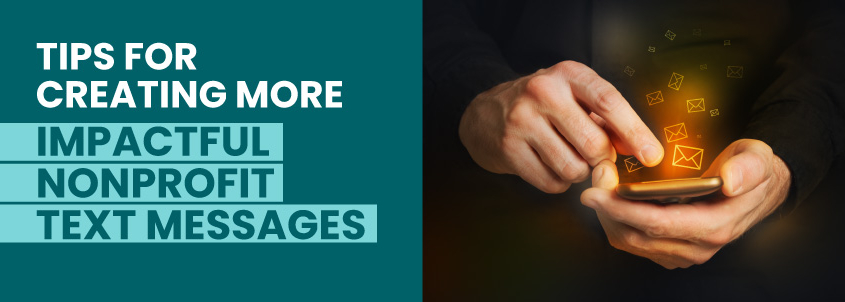4 Tips for Creating More Impactful Nonprofit Text Messages
Text messages are highly appealing to organizations looking to connect with more supporters—they’re fast, simple, and have the highest open rate of any nonprofit communication channel (98%). Instead of spending hours crafting the perfect email that donors may not even read, your team can send personal messages via text that supporters will see in minutes. But in order to access the many benefits of SMS marketing, you have to approach it strategically. If you’re new to nonprofit text communications or you’re struggling to make an impact with your current texting strategy, use these top tips to send more effective messages:
- Integrate texts into a multichannel strategy.
- Segment your supporters.
- Vary your message content.
- Align your tone with the format.
With these tips, you’ll be more equipped to reach your nonprofit’s text fundraising, marketing, and donor stewardship goals. Let’s dive in so you can start sending texts that pack more of a punch.
1. Integrate texts into a multichannel strategy.
As with any kind of marketing, you don’t want to send texts blindly without a targeted strategy behind them. Every message you send should have a goal, whether that’s to raise funds for your latest campaign or improve your organization’s relationship with a specific group of supporters.
The easiest way to formulate a better texting strategy and ensure it supports your other communication channels is by incorporating texts into a wider multichannel marketing plan. This will not only give you a clearer picture of your goals for each text message but also present your target audience with a unified, consistent view of your organization.
To fit texts into your existing communication strategy, consider using them for:
- Thanking donors: According to eCardWidget’s donor recognition guide, it’s vital to thank donors promptly—ideally within 48 hours of their donation. This makes texts the perfect method for sending an immediate thank-you message. After texting, you can plan to send more formal thanks via email or direct mail later.
- Event marketing: Texts are easy to fit into event marketing campaigns since they can cover a wide range of needs. For instance, you could send texts to invite supporters to the event, remind them to register on your website, thank them for attending, or update them on the total amount of funds the event raised.
- Urgent reminders and updates: Have a last-minute change of plans or need supporters to take action quickly? Texts are the fastest way to reach your support base. Make sure to keep these messages concise and straightforward so recipients can gauge what to do quickly.
- Relationship building: Whether you want to start a relationship off well with someone who just joined your mailing list or retain more recurring donors, you can create more opportunities for genuine connection by sending text messages. In particular, try to engage supporters in one-to-one conversations by inviting them to respond directly.
Consider using a content calendar to plot out specific messages and the channels you’ll use to send them for each campaign you run.
For instance, say you’re hosting a fundraising gala on April 19. You might plan to send a formal invitation via direct mail at the beginning of March, and then promote the event on social media and your website throughout the month. On March 15 and April 2, you might send text reminders to register for the event. You might also send immediate thank-you texts to each registrant followed by a longer email with event details.
2. Segment your supporters.
Since your recipients are likely to read every text you send promptly, it can be easy to overwhelm them if you send too many messages. Supporters don’t want to feel bombarded by texts or receive messages that don’t apply to them, so it’s vital to make every text you send highly relevant to the recipient.
A simple way to increase the relevance of all your texts is to segment supporters and tailor messages to each group.
These segments can vary widely depending on your nonprofit’s goals. For example, one organization aiming to engage younger supporters might create a segment of Gen Z supporters who have shown interest in donating but haven’t made a gift yet. Another nonprofit promoting an auction might segment supporters based on past attendance. They could text a group of previous auction guests an early registration link, then invite those who’ve attended other fundraising events separately.
You can create these segments within your CRM, marketing automation tool, or text marketing app. No matter how you create these groups, be sure to revisit them periodically so they stay up-to-date and aligned with your organization’s priorities.
3. Vary your message content.
If you’ve only sent one type of text message before, such as a bulk text-to-give appeal, you’re missing out on a wealth of other opportunities that texts provide nonprofits. Plus, you run the risk of sounding repetitive to supporters, which might lead them to opt out of future messages.
To keep recipients engaged, vary the types of messages you send and try to keep your content fresh. Mogli’s Salesforce SMS guide suggests mixing up three main types of messages to add variety to your text content: 
- One-to-one texts: Personal messages sent to individual supporters are ideal for building relationships and stewarding donors. Use this type of message for personal thank-you texts, tailored fundraising appeals, and volunteer recruitment.
- Bulk texts: Texts sent to your entire donor base or specific segments of supporters work well for announcing events, campaign results, urgent updates, and more. Use bulk texts sparingly so you don’t overwhelm recipients with too many messages.
- Automated texts: By using a text marketing app that integrates with your CRM, you can automate thank-you messages, event reminders, and even in-depth text surveys. By pulling donor data from your CRM into the messages, you can keep the same level of personalization while saving your team time and effort.
If your texting software allows, you can also mix up your text message content by sending multimedia like photos, infographics, emojis, and GIFs. These texts will draw extra attention, and they can often communicate ideas better than words alone.
4. Align your tone with the format.
Texts are naturally a much more personal communication channel than email and direct mail. They’re comparable to social media in terms of their casual feel, but they work on a more personal level since they go directly to individual recipients.
Using a casual tone in your texts will help you boost this personalization, encourage supporters to respond, and make them feel like they’re getting to know your organization personally. It’ll also make it easier for you to write shorter messages that hold supporters’ attention.
To jumpstart your creativity, get inspired by the following example texts:
- Deborah, are you interested in volunteering at the animal shelter again next weekend? The kittens would be especially grateful! 🐈
- Have you seen the news? SC Reps want to cut funding for our public schools AGAIN. Text EDUCATE to sign our petition to stop the budget cuts.
- Thanks so much for your $50 donation, Shachia! We ❤️ dedicated supporters like you who help us protect the environment 🌳
Just remember not to alter your tone so much that it feels off-brand for your organization. Stick to any rules about tone and writing style that are in your nonprofit’s brand guidelines so all of your communications stay consistent.
After trying out these strategies, don’t forget to track your text campaigns’ performance by monitoring metrics like response rates, click-through rates, and opt-out rates. When you see messages with especially high response or click-through rates, note the tactics you used in those texts and use similar ones moving forward.
